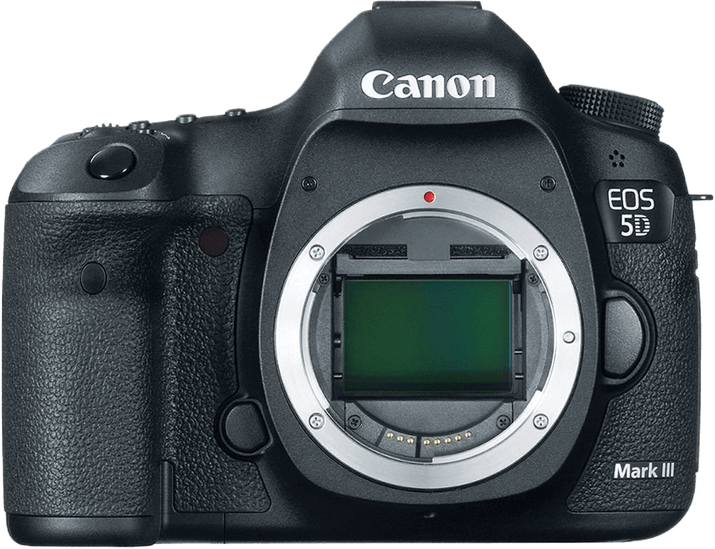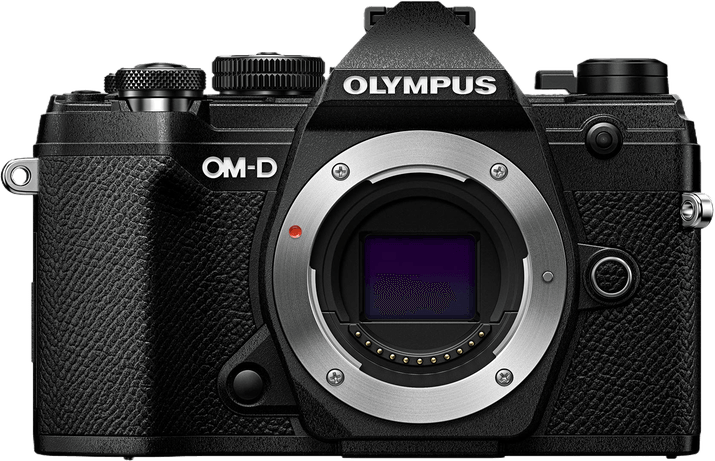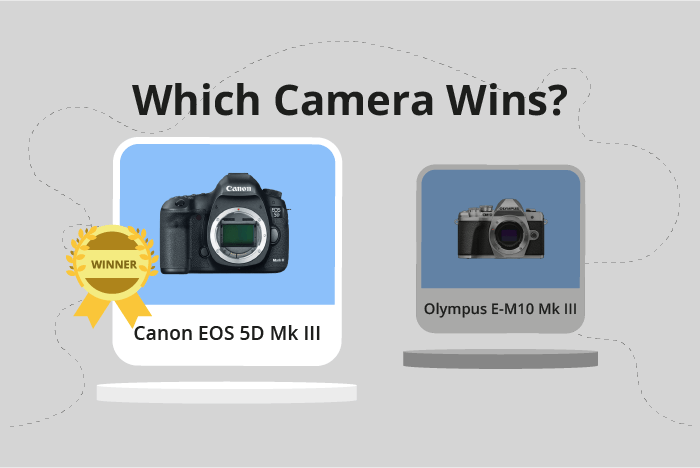Canon EOS 5D Mark III vs Olympus OM-D E-M10 Mark III Comparison
Canon EOS 5D Mark III

Olympus OM-D E-M10 Mark III

The Canon EOS 5D Mark III is the winner with a score of 65/100, while the Olympus OM-D E-M10 Mark III scores 54/100. Both cameras have different types: the Canon is a DSLR and the Olympus is mirrorless. They share similarities in their announcement and release years, with the Canon launching in 2012 and the Olympus in 2017.
The Canon EOS 5D Mark III outperforms the Olympus with its larger size (152 x 116 x 76mm) and heavier weight (950g / 2.09lbs), making it more suitable for professional use. However, the Olympus OM-D E-M10 Mark III has its advantages too. It’s more compact (122 x 84 x 50mm) and lightweight (410g / 0.90lbs), making it a more travel-friendly option.
Despite the higher score of the Canon EOS 5D Mark III, it comes with a higher launch price of $3499 compared to the Olympus OM-D E-M10 Mark III’s $650. This makes the Olympus a more budget-friendly option for those who prioritize affordability. When considering these factors, the Canon camera is better suited for professional use, while the Olympus camera is a more budget and travel-friendly option.
Canon EOS 5D Mark III vs Olympus OM-D E-M10 Mark III Overview and Optics
The Canon EOS 5D Mark III outperforms the Olympus OM-D E-M10 Mark III in optics with a score of 67/100 compared to 57/100. Both cameras share common specifications, such as a CMOS sensor type and a similar processor. However, they have differences that contribute to the superior optics of the Canon EOS 5D Mark III.
The Canon EOS 5D Mark III has a higher megapixel count at 22.3, compared to the Olympus OM-D E-M10 Mark III’s 16 megapixels. This provides the Canon camera with better image resolution and detail. Additionally, the 5D Mark III features a full-frame sensor, which offers better low light performance and a shallower depth of field compared to the E-M10 Mark III’s Micro Four Thirds sensor. The Canon camera also has a higher DXOMARK score for its sensor at 81, compared to 73 for the Olympus camera.
In contrast, the Olympus OM-D E-M10 Mark III has a faster shooting speed of 8.6 compared to the Canon EOS 5D Mark III’s 6. This allows the Olympus camera to capture fast-moving subjects more effectively. The E-M10 Mark III also offers image stabilization, which the 5D Mark III lacks.
Despite the Olympus OM-D E-M10 Mark III’s advantages in shooting speed and image stabilization, the Canon EOS 5D Mark III’s higher megapixel count, full-frame sensor, and better DXOMARK score make it the superior camera in terms of optics. The Olympus E-M10 Mark III is still a solid camera with specific strengths, but the Canon 5D Mark III offers a more versatile and higher-quality optical performance.
Canon EOS 5D Mark III vs Olympus OM-D E-M10 Mark III Video Performance
The Olympus OM-D E-M10 Mark III emerges as the winner in the video capabilities comparison, scoring 83/100, while the Canon EOS 5D Mark III scores 56/100. Both cameras share some features, such as the maximum video frame rate of 60fps. However, several differences set these two cameras apart.
The Olympus OM-D E-M10 Mark III excels with its 4K video resolution and larger video dimensions of 3840 x 2160. This allows for higher quality video recording compared to the Canon EOS 5D Mark III, which has a maximum video resolution of Full HD and video dimensions of 1920 x 1080. Additionally, the Olympus camera includes built-in time-lapse functionality, which the Canon camera lacks. These features contribute to the Olympus camera’s better performance in the video department.
The Canon EOS 5D Mark III, on the other hand, does not outperform the Olympus OM-D E-M10 Mark III in terms of video capabilities. However, it is worth noting that the Canon camera still offers Full HD video resolution and a 60fps frame rate, which can be adequate for certain video recording needs.
Therefore, the Olympus OM-D E-M10 Mark III is the superior choice for those seeking better video quality and additional features such as time-lapse. The Canon EOS 5D Mark III, while not as advanced in video capabilities, can still meet basic video recording requirements. Ultimately, the choice depends on the specific needs and preferences of the user.
Canon EOS 5D Mark III vs Olympus OM-D E-M10 Mark III Features and Benefits
The Canon EOS 5D Mark III wins in features with a score of 59/100, while the Olympus OM-D E-M10 Mark III achieves a score of 57/100. Both cameras have a screen resolution of 1,040,000 dots and do not feature GPS or Bluetooth.
The Canon EOS 5D Mark III excels with a larger screen size of 3.2 inches, compared to Olympus’s 3-inch screen. However, the 5D Mark III does not have a touchscreen, flip screen, or WiFi capabilities.
On the other hand, the Olympus OM-D E-M10 Mark III offers a touchscreen and a flip screen, enhancing user experience and making it easier to capture shots from different angles. Additionally, it has WiFi capabilities for easy sharing and transferring of images. These features make the Olympus OM-D E-M10 Mark III more versatile than the Canon EOS 5D Mark III, despite having a slightly smaller screen size.
To conclude, the Canon EOS 5D Mark III wins in features by a small margin, mainly due to its larger screen size. However, the Olympus OM-D E-M10 Mark III offers more modern and convenient features such as a touchscreen, flip screen, and WiFi connectivity. Ultimately, the choice between these two cameras will depend on the user’s priorities and preferences, with the Canon EOS 5D Mark III offering a larger display and the Olympus OM-D E-M10 Mark III providing greater versatility and connectivity.
Canon EOS 5D Mark III vs Olympus OM-D E-M10 Mark III Storage and Battery
The Canon EOS 5D Mark III outperforms the Olympus OM-D E-M10 Mark III in storage and battery, with a score of 76/100 compared to 21/100. Both cameras have common specifications, such as accepting SD/SDHC/SDXC memory cards and lacking USB charging.
The 5D Mark III excels with its two memory card slots, supporting Compact Flash and UDMA, and a battery life of 950 shots using the LP-E6 battery. This provides greater storage flexibility and longer shooting sessions.
The E-M10 Mark III, however, falls short with only one memory card slot and a battery life of 330 shots using the BLS-50 battery. Its advantage lies in its compatibility with UHS-II SD cards, allowing for faster read and write speeds.
Considering these factors, the Canon EOS 5D Mark III offers superior storage and battery performance, while the Olympus OM-D E-M10 Mark III provides faster memory card compatibility.
Canon EOS 5D Mark III vs Olympus OM-D E-M10 Mark III – Our Verdict
Are you still undecided about which camera is right for you? Have a look at these popular comparisons that feature the Canon EOS 5D Mark III or the Olympus OM-D E-M10 Mark III:

